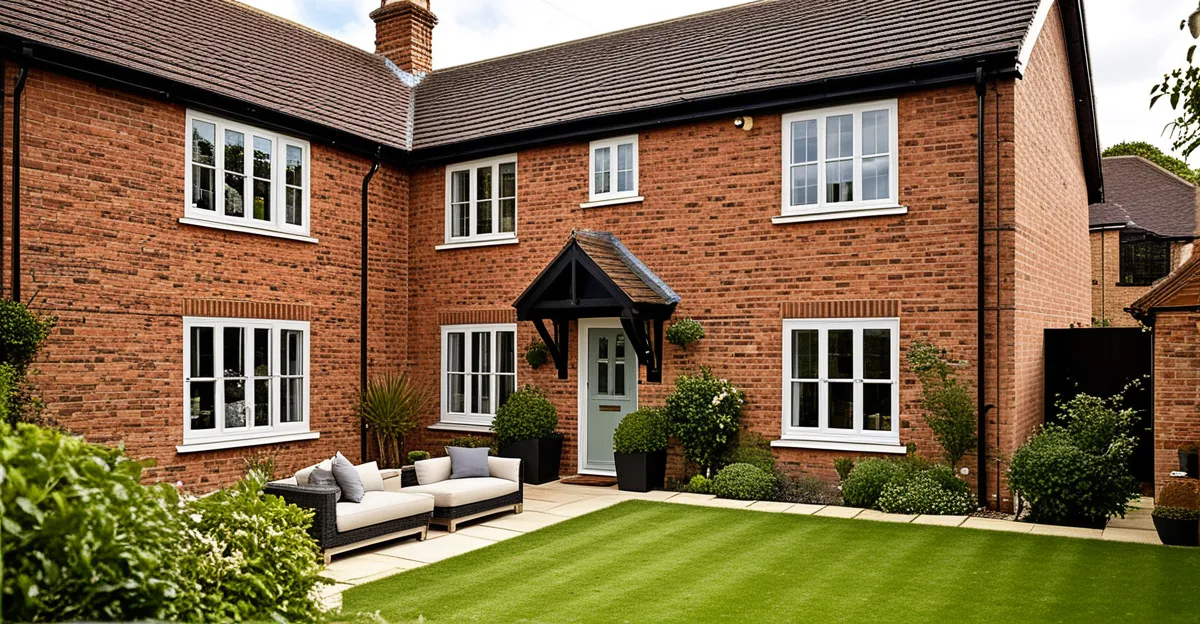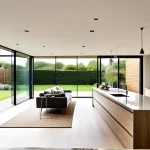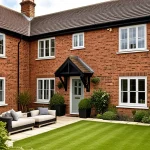Overview of Traditional UK Home Design
Traditional UK home design is a fascinating tapestry woven from the past, exhibiting a rich historical context that echoes through its various architectural styles. Rooted in a tapestry of historical influences, these homes display a blend of practicality and elegance. Each region in the UK showcases its unique flavor in home design, reflecting local traditions and resources.
One of the most popular architectural styles is the Victorian, known for its elaborate ornamentation and intricate architectural styles UK. These homes often feature decorative brickwork, stained glass, and asymmetrical facades. Moving further back in time, the Georgian architecture is characterized by symmetry, proportion, and simplicity, with grand townhouses often lined with sash windows and pediments.
Topic to read : What Are the Key Trends in Modern UK Home Design?
Regional variations add further depth to the features of UK homes. For instance, Scottish homes might include sturdy stonework ideal for withstanding harsher climates, while English cottages often embrace a charm with thatched roofs and timber framing. This regional distinction adds a layer of identity to the traditional UK home design, making each home truly unique in its representation of both style and function.
Architectural Styles
Understanding the architectural styles prevalent in the UK is vital to appreciating traditional homes’ diversity and charm.
In parallel : How Can Small Changes in Interior Design Enhance Your Home Living Experience?
Victorian Style
Victorian homes are renowned for their elaborate details and ornate design. These homes frequently boast decorative brickwork, reflecting the Industrial Revolution’s influence, which made intricate brick designs more accessible. Stained glass windows are a hallmark feature, adding vibrant hues and intricate designs to the facade. The asymmetrical facades not only display a bold architectural statement but also highlight the era’s love for complex, layered aesthetics. Interiors often feature elaborate fireplaces and high ceilings, enhancing both grandeur and comfort.
Georgian Style
Georgian architecture is celebrated for its symmetry and proportion. Its design is influenced by classical Roman and Greek architecture, exuding a sense of balance and order. Townhouses during this period typically present a uniform look, with lines of sash windows and elegant pediments as common features. The interiors of Georgian homes are characterized by panelled walls, ornamental plasterwork, and marble fireplaces, embodying the era’s sophisticated elegance and emphasizing open, airy spaces.
Tudor Revival
The Tudor Revival style draws inspiration from medieval English architecture, often seen in homes built during the late 19th and early 20th centuries. This style is easily recognized by its half-timbering, where wooden beams are exposed on the building’s exterior, set against a backdrop of stucco. Rooflines are usually steep and may feature tall chimneys and small-paned windows. This revival style captures the nostalgia and romanticism of the past, blending it seamlessly with modern innovations of its time, offering a unique juxtaposition of historical charm and contemporary living.
Key Materials Used
Understanding the building materials in traditional UK homes provides insight into their enduring charm and resilience. Brick is one of the most prevalent materials, celebrated for its durability and thermal properties. Historically, local clay availability influenced brick color and texture, adding regional character. Bricks not only provide structural strength but are also resistant to weather conditions, making them ideal for the UK’s varied climate.
Timber framing is another significant element, especially in styles like the Tudor Revival. This method involves using timber beams as both structural and decorative features. Timber’s flexibility and aesthetic appeal allow for creative designs, making it a timeless choice that harmonizes well with other materials.
Stone plays a crucial role, particularly in regions like Scotland, where stonework is essential for withstanding harsh climates. Its insulation properties and natural beauty make it a favored choice, offering both practicality and elegance. Stone is often used for base structures and decorative elements, contributing to the home’s character and heritage.
The thoughtful combination of these materials defines the features of UK homes, showcasing regional preferences and historical context. Each material not only serves a functional purpose but also adds to the unique narrative of traditional UK home design.
Roof Types and Designs
When examining traditional UK home design, the roof types greatly contribute to architectural character and regional distinction. Each roof approach not only serves functional purposes but also articulates the aesthetic charm associated with its style.
Gable Roofs
Gable roofs stand as a quintessential element in many architectural styles UK, distinguished by their simple and effective triangular shape. This design is celebrated for its ability to shed water and snow efficiently, which is particularly beneficial in the UK’s varied climate. In addition to functionality, gable roofs provide homes with generous attic space, enabling extra storage or even conversion into additional living areas. The peak of a gable roof defines sharp, clean lines, complementing both Victorian homes and more modern constructions alike.
Hipped Roofs
Hipped roofs, offering a distinct contrast, slope downwards on all sides, forming a more subtle and robust silhouette. This type of roof is prevalent in Georgian architecture due to its ability to withstand strong winds, making it ideal for the windy conditions in some parts of the UK. The gentle inclination of hipped roofs also allows for consistent exterior finishes and seamless integration with the overall geometric balance of Georgian designs. Their enclosed eaves can enhance the aesthetic appeal, adding depth and a streamlined look to the exterior of homes.
Thatched Roofs
Thatched roofs hold a nostalgic appeal, connecting modern observers with bygone eras, particularly among English cottages and characterful inns. Crafted from layers of straw or reeds, this roofing style insulates homes while simultaneously embodying the rustic elegance of traditional UK home design. Aside from visual allure, thatched roofs offer excellent thermal properties, keeping interiors warm in winter and cool during summer months. Their historical roots are highlighted by the craftsmanship involved, preserving a significant aspect of regional identities, especially in rural parts of England.
Understanding these roof types UK homes equips appreciators of architectural history with a nuanced perspective of traditional styles’ form and function.
Window Styles
In the tapestry of traditional UK home design, window styles play a significant role in defining the overall aesthetic and functionality of homes. These features of UK homes have evolved, mirroring the architectural styles and regional preferences of the time.
Sash windows are a quintessential element of Georgian architecture, known for their elegant simplicity and practicality. These vertically sliding windows often incorporate multiple smaller panes and are valued for their ability to facilitate ventilation while maintaining the classic symmetry of Georgian facades. The traditional sash design also minimizes the intrusion of exterior elements, contributing to its enduring appeal.
Bay windows, on the other hand, offer a more dramatic architectural detail, prominent in Victorian homes. Protruding from the facade, they invite natural light and create a sense of space by extending living areas. The extended sill can serve as a quaint niche for seating or decorative displays, adding charm and functionality. Their elaborate frames echo the ornate tastes of the Victorian era, enhancing both the exterior and interior ambiance.
Regional variations also influence window styles UK homes, with Scottish homes often featuring larger paned windows to maximize sunlight in regions with longer periods of twilight. In the south of England, you might find casement windows with timber or metal frame features, adhering to local material availability and stylistic preferences.
The thoughtful integration of these window designs not only enhances the home’s character but also underscores historical context, reflecting both the traditional and adaptive nature of UK architecture.
Incorporating Traditional Elements in Modern Design
Blending modern home design with traditional elements offers a dynamic fusion of past and present, enabling homeowners to enjoy the benefits of both styles. Successfully merging these elements requires a thoughtful approach to integration, ensuring that classic features don’t overshadow the sleek lines and open spaces of contemporary designs.
Strategies for Integration involve identifying standout traditional features worth preserving or recreating, such as intricate moldings or iconic fireplaces. These can serve as focal points around which modern elements are harmoniously arranged. For example, pairing a Victorian-style fireplace with minimalist furniture can maintain historical charm while promoting modern aesthetics.
Examples of Blending Styles can be seen in designs where classic sash windows are preserved, set against stark, modern facades. Kitchens and bathrooms might integrate traditional materials like stone and wood, ensuring continuity with the home’s original character while accommodating modern appliances and fittings.
Maintaining Authenticity is crucial, even as renovations introduce contemporary designs. Carefully selecting paint colors, textures, and materials that echo the era’s original palette helps achieve this. It’s also important to respect the initial architecture, perhaps by featuring exposed beams or retaining original floor layouts, to create a seamless old-meets-new experience.
This captivating interplay between tradition and innovation not only enhances aesthetic appeal but also enriches the living environment, making for timeless home design.
Interior Features
The interior design of UK homes is a cornerstone of their charm and historical significance, adeptly combining beauty and practicality. Various features, such as fireplaces and moldings, add unique character to these classic interiors.
Fireplaces
Fireplaces in traditional UK homes often serve as central, focal points. These elements range from grand marble structures found in Georgian homes to ornate cast-iron designs typical of the Victorian era. Their styles not only reflect the architectural period of the home but also provide warmth and ambiance, embodying both function and elegance. For generations, the fireplace has been a gathering place, enhancing social interaction and creating memories.
Molding and Trim
Moldings and trim are integral to the interior design UK homes, providing a seamless connection between walls and ceilings or framing doorways and windows with style. Wealthy homeowners during the Georgian and Victorian periods favored intricate plasterwork, showcasing their status and appreciation for fine craftsmanship. From the modest bead molding to the more elaborate egg-and-dart designs, each style adds a subtle yet sophisticated touch to interiors, enhancing both the aesthetic and structural integrity of traditional homes.
Floor Plans
Traditional UK homes showcase thoughtful floor plans that balance private and social living spaces. Homes from the Georgian period often consist of symmetrical layouts, reflecting an emphasis on order and proportion. Victorian homes, while maintaining this elegance, introduced more complex and layered arrangements, allowing for greater intimacy and personal expression. These timeless layouts create functional environments, facilitating daily life while preserving the historic essence of UK architecture.







